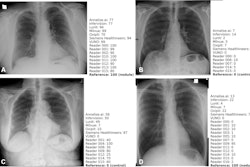Human-AI symbiosis – rather than totally autonomous AI – should be the current goal for AI in chest radiography, according to an editorial published January 23 in Radiology.
“In the coming years, radiologists will find themselves working in a reimagined diagnostic cockpit, increasingly interpreting chest radiographs and other imaging studies in symbiotic partnership with AI,” proposed lead author Warren Gefter, MD, of the University of Pennsylvania in Philadelphia, and colleagues.
To achieve this vision, radiologists will need to apply the goals of “human-centered AI” and symbiosis to the design and implementation of AI in chest radiography, the authors wrote. This will help ensure that AI remains safe, reliable, and trustworthy, they suggested.
For radiology, the key will be well-designed, nondisruptive user interfaces and collaborative AI radiologist workflows. These must include AI explainability techniques, which provide clues to the basis for the model’s decisions, confidence levels for predictions, and editing functions to allow radiologists to immediately modify erroneous results, they wrote.
For its part, the AI could display a warning signal when it suspects human error or an alert when its own confidence levels are low. To that end, uncertainty quantification methods, which allow AI models to provide such confidence levels for their predictions, are being actively investigated, the authors noted.
Moreover, this human-AI symbiosis could also allow determinations for who the dominant reader should be: AI for clear-cut cases and radiologists for those about which AI is uncertain, for instance. Systems would also need to be in place to provide ground truth feedback to the human-AI pair, the group added.
“With the right interface and workflow, we can harness the enormous benefits of AI for chest radiography while minimizing the dangers. In their symbiotic interaction, the radiologist and AI each can end up better than they might have been on their own,” the group wrote.
Ultimately, AI algorithms have already been developed that can autonomously detect chest radiograph findings better human radiologists, the authors wrote. These results have been so impressive that some question whether AI will replace humans altogether, they noted.
However, this “pitting human against machine” only raises unnecessary fears for radiologists and obscures the real path forward, according to the group.
“There are cases where an AI can outperform a human, and vice versa, but, if it’s done right, neither the AI nor the radiologist can outperform a human-AI partnership,” they wrote.
Gefter’s co-authors included Mathias Prokop, MD, PhD, of Radboud University in Nijmegen, the Netherlands; Joon Beom Seo, MD, PhD, of the University of Ulsan College of Medicine in Seoul, South Korea; Suhail Raoof, MD, of Northwell Health in New York City; Curtis Langlotz, MD, PhD, of Stanford University in Palo Alto, CA; and Hiroto Hatabu, MD, PhD, of Harvard Medical School in Boston.
A link to the full article can be found here.



















